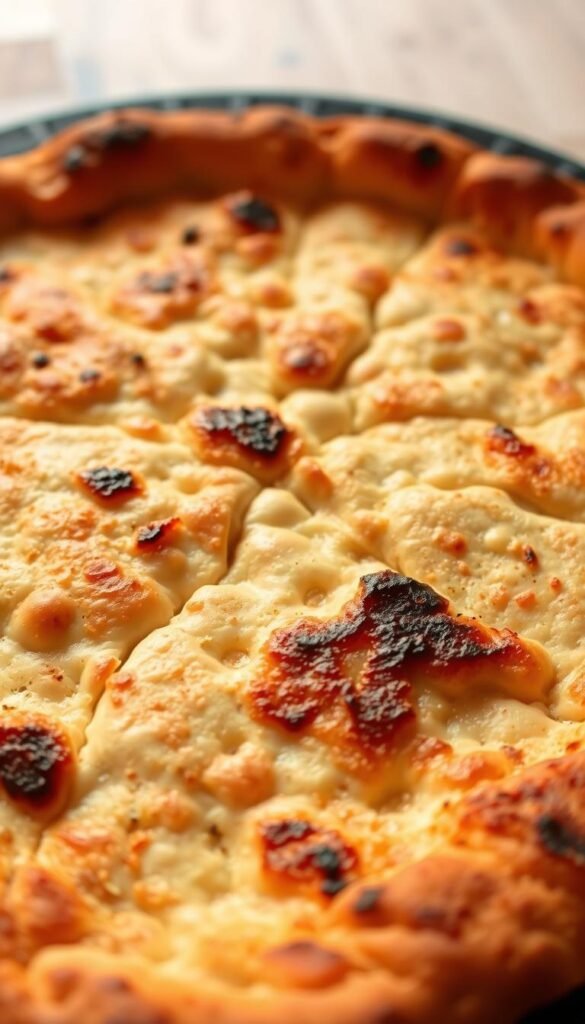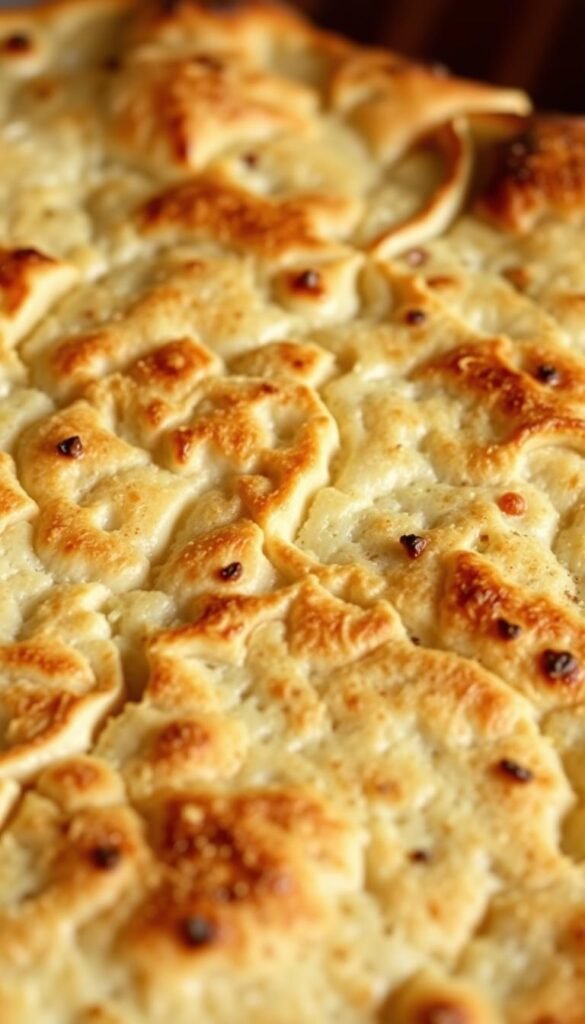25 Sourdough Pizza Dough Recipes for Crispy Crusts
A perfectly crispy crust is the holy grail of homemade pizza. With the rise of artisanal baking, sourdough pizza dough has become a favorite among pizza enthusiasts. Did you know that using a natural starter instead of commercial yeast can elevate your pizza game? The unique fermentation process involved in creating sourdough not only enhances flavor but also contributes to a crunchier crust.
Our comprehensive guide introduces you to the world of homemade sourdough pizza, featuring 25 diverse recipes designed to help you achieve that perfect crispiness. From basic starters to advanced techniques, we’ve got you covered. Whether you’re a seasoned baker or just starting out, our recipes and tips will help you create crispy pizza crusts that rival those from your favorite pizzeria.
Key Takeaways
- Learn the basics of creating a sourdough starter for pizza.
- Discover techniques for achieving a crispy crust with sourdough pizza dough.
- Explore 25 unique recipes for homemade sourdough pizza.
- Understand the science behind sourdough fermentation and its impact on pizza.
- Get tips on troubleshooting common issues with sourdough pizza dough.
The Magic of Sourdough Pizza
Sourdough pizza represents a perfect blend of artisanal craftsmanship and nutritional value. This unique combination is what sets sourdough pizza apart from its conventional counterparts. The process of creating sourdough pizza involves a natural starter culture instead of commercial yeast, leading to a more complex flavor profile and improved nutritional content.
What Makes Sourdough Pizza Crust Superior
The superiority of sourdough pizza crust lies in its complex flavor profile and unique texture. The longer fermentation time allows for a more developed gluten structure, resulting in a crust that is both chewy and crispy. This process also contributes to the formation of a more open crumb structure, characteristic of artisanal pizzas.
The use of a natural starter culture instead of commercial yeast is key to achieving this superior crust. It not only enhances the flavor but also improves the digestibility of the pizza.
| Characteristics | Sourdough Pizza Crust | Conventional Pizza Crust |
|---|---|---|
| Flavor Profile | Complex, tangy | Simple, yeasty |
| Texture | Chewy and crispy | Soft or hard |
| Crumb Structure | Open, airy | Dense |
Health Benefits of Sourdough Fermentation
Sourdough fermentation offers numerous health benefits. The process breaks down phytic acid, a compound that inhibits mineral absorption, thereby increasing the availability of minerals like iron, zinc, and magnesium.
This fermentation process also creates prebiotic compounds that can aid in gut health. Moreover, the lactic acid produced during fermentation can make the pizza more digestible, potentially benefiting individuals with mild gluten sensitivities.
Getting Started with Sourdough for Pizza
The art of crafting sourdough pizza starts with cultivating a vibrant sourdough starter, a process that requires patience and dedication. A sourdough starter is a naturally occurring mixture of wild yeast and bacteria that, when properly maintained, becomes the leavening agent in your pizza dough.
Creating and Maintaining Your Sourdough Starter
To create a sourdough starter, mix equal parts of flour and water in a clean container, and let it sit at room temperature. Over the next few days, you’ll need to feed it regularly, discarding half of the starter each time, until it becomes bubbly and nearly doubles in size. Maintaining your starter involves a regular feeding schedule, proper storage, and occasional revival techniques if it becomes sluggish.
Tips for Maintaining Your Sourdough Starter:
- Feed your starter once a day if you’re baking frequently.
- Store it in the refrigerator and feed it once a week if you’re baking less often.
- Revive a neglected starter by feeding it regularly for a few days.
Essential Equipment for Sourdough Pizza Making
Having the right equipment can significantly enhance your sourdough pizza making experience. Essential tools include a digital scale for precise measurements, a thermometer to monitor temperatures, and a pizza stone or steel for achieving a crispy crust.
| Equipment | Purpose |
|---|---|
| Digital Scale | Precise ingredient measurement |
| Thermometer | Monitoring dough and environment temperature |
| Pizza Stone/Steel | Achieving a crispy crust |
| Proofing Containers | Controlled environment for dough rise |

25 Sourdough Pizza Dough Recipes for Crispy Crusts
Exploring the world of sourdough pizza dough recipes reveals a vast array of possibilities for creating the perfect crispy crust. Sourdough pizza has gained popularity for its unique flavor profile and texture, which is achieved through the natural fermentation process. This section will delve into 25 distinct sourdough pizza dough recipes, categorized into classic bases, whole grain variations, specialty flour pizzas, flavored doughs, and technique-focused recipes.
Classic Sourdough Pizza Bases
Classic sourdough pizza bases form the foundation of various traditional pizza styles. These recipes focus on the simplicity and authenticity of their respective pizza-making traditions.
1. Traditional Neapolitan-Style Sourdough Pizza Dough
This recipe adheres to the traditional Neapolitan pizza-making method, emphasizing simplicity and high-temperature baking. The dough is made with type ’00’ flour, water, salt, and sourdough starter. The result is a crust that is soft, chewy, and slightly charred.
2. New York-Style Sourdough Pizza Base
New York-style sourdough pizza is known for its large, thin, and foldable slices. This recipe achieves the perfect fold and chew by using a high-gluten flour and a longer fermentation time. The crust is crispy on the outside and soft on the inside.
| Recipe | Flour Type | Fermentation Time | Crust Characteristics |
|---|---|---|---|
| Traditional Neapolitan | Type ’00’ Flour | 24 hours | Soft, Chewy, Slightly Charred |
| New York-Style | High-Gluten Flour | 48 hours | Crispy Outside, Soft Inside |
3. Overnight Cold Fermented Sourdough Pizza Dough
Cold fermentation enhances the flavor complexity of the dough. This recipe involves mixing the ingredients and letting them ferment in the refrigerator overnight. The slow fermentation process develops a deeper flavor profile.
4. Sourdough Sicilian-Style Pizza Base
Sicilian-style pizza is known for its thick crust and rich toppings. This sourdough version uses a longer fermentation time to develop a complex flavor and a tender, airy crust.
5. Sourdough Detroit-Style Pizza Crust
Detroit-style pizza is characterized by its square shape and thick, cheesy crust. This sourdough recipe incorporates a longer fermentation time to enhance the flavor and texture of the crust.

Whole Grain Sourdough Pizza Variations
Whole grain sourdough pizzas offer a healthier alternative without compromising on flavor. These recipes explore different whole grains and their effects on the dough.
6. Whole Wheat Sourdough Pizza Crust
Whole wheat sourdough pizza crust is made with whole wheat flour, which provides a nuttier flavor and denser texture. Adjusting the hydration level is crucial to achieve the right consistency.
7. Rye Blend Sourdough Pizza Dough
Rye blend sourdough combines the earthy flavor of rye with the tanginess of sourdough. This recipe requires careful handling to balance the flavors and achieve a crispy crust.
| Whole Grain | Flavor Profile | Texture |
|---|---|---|
| Whole Wheat | Nuttier | Denser |
| Rye Blend | Earthy, Tangy | Crispy |
Mastering Sourdough Pizza Techniques
Elevating your sourdough pizza game involves refining your techniques in kneading, fermentation, and shaping. Mastering these elements is crucial for producing high-quality sourdough pizzas with crispy crusts and well-developed flavors.
Proper Kneading and Folding Methods
The technique used for kneading or folding sourdough pizza dough significantly impacts the final product’s texture and flavor. Unlike traditional kneading, which can be vigorous and lead to over-developed gluten, gentle folding methods are preferred for sourdough. This approach helps maintain the delicate balance of the dough’s structure.
- Gentle folding techniques preserve the dough’s integrity and promote even fermentation.
- Visual cues, such as the dough’s sheen and its ability to hold a shape, indicate optimal development.
- Adjusting folding techniques based on flour type and hydration level is crucial for achieving the desired dough characteristics.
Fermentation and Proofing Tips
Fermentation is a critical step in sourdough pizza making, influencing both flavor and texture. Temperature control is key to managing fermentation rates, allowing for flexibility in scheduling and flavor development.
- Monitor bulk fermentation indicators, such as volume increase and bubble formation, to gauge progress.
- The windowpane test can be used to assess gluten development during fermentation.
- Use the finger-dent test to determine if the dough is properly proofed and ready for shaping.
Shaping and Stretching Your Dough
Shaping sourdough pizza dough requires a gentle touch to preserve the delicate structure developed during fermentation. Techniques for creating even thickness and managing bubble formation are essential for a uniform crust.
- Handle the dough gently to prevent tearing, especially when stretching to the desired thickness.
- Techniques may vary based on the dough’s hydration level and flour type, requiring adaptability.
- Practice shaping different dough compositions to develop a keen sense of how they respond to handling.
By mastering these techniques, you’ll be able to produce sourdough pizzas that are not only delicious but also visually appealing, with a crispy crust and well-balanced flavors.
Baking Methods for the Perfect Crispy Crust
Baking sourdough pizza is both a science and an art, requiring precision and practice to achieve that perfect crispy crust. The baking process is the final step in transforming your carefully prepared dough into a culinary masterpiece. Different baking methods can significantly impact the final product, and understanding these techniques is crucial for achieving the desired crispiness.

Home Oven Adaptations
Not everyone has access to a dedicated pizza oven, but that doesn’t mean you can’t achieve a crispy crust at home. Home oven adaptations involve maximizing the potential of your standard residential oven. To start, preheating your oven to its highest temperature setting (usually around 500-550°F) is essential. Using the broiler function can also help simulate the high temperatures of a pizza oven.
- Preheat your oven for at least 30 minutes to ensure it reaches a stable high temperature.
- Use a baking steel or stone to enhance heat retention and distribution.
- Position your oven rack in the center or lower third of the oven to allow for optimal air circulation.
Humidity control is another critical factor. A dry environment helps to create a crispy crust, while a steamy environment can lead to a softer crust. You can control humidity by using a spray bottle to mist the oven walls or by placing a pan of water on the lower rack.
Using Pizza Stones and Steel
Pizza stones and steel are popular baking surfaces that can significantly enhance the crispiness of your crust. Both materials have high thermal mass, which allows them to retain heat and cook the crust more evenly.
Key differences between pizza stones and steel:
| Feature | Pizza Stone | Pizza Steel |
|---|---|---|
| Heat Retention | Good, but can vary by type | Excellent |
| Preheating Time | Longer, typically 30-60 minutes | Shorter, typically 15-30 minutes |
| Durability | Can be brittle and prone to cracking | More durable and less prone to damage |
To get the most out of your pizza stone or steel, preheat it for the recommended time and use a pizza peel or a piece of parchment paper to transfer your dough.
Outdoor Pizza Oven Techniques
For those with access to an outdoor pizza oven, the possibilities for achieving a perfectly crispy crust expand. Outdoor pizza ovens can reach extremely high temperatures (often exceeding 900°F) and provide a cooking environment that closely mimics traditional Neapolitan pizza ovens.
“The key to a great Neapolitan pizza is a hot oven, and I mean really hot. The hotter the oven, the quicker the pizza cooks, and the better it tastes.” –
When using an outdoor pizza oven, managing temperature and flame positioning is crucial. For sourdough pizzas, a slightly lower temperature than traditional pizza dough is often recommended, as sourdough can be more sensitive to high heat.
- Monitor the temperature of your oven and adjust the flame as necessary.
- Rotate your pizza regularly to ensure even cooking.
- Use a pizza peel to quickly and safely transfer your pizza in and out of the oven.
Storing and Freezing Sourdough Pizza Dough
Mastering the art of sourdough pizza dough storage is crucial for home bakers who want to enjoy their favorite pizzas at any time. Proper storage techniques allow for flexibility in meal planning and can significantly enhance the overall quality of the final product.
When it comes to short-term storage, refrigeration is a viable option. Refrigerating sourdough pizza dough slows down the fermentation process, allowing for a more complex flavor development. To refrigerate dough effectively, it’s essential to store it in a container that allows for expansion while preventing drying out.
Refrigeration Methods
For optimal results, refrigerate the dough after the initial bulk fermentation but before final proofing. Use a lightly oiled container or a proofing basket covered with a damp cloth or plastic wrap. The dough can typically be refrigerated for up to 3 days, depending on the recipe and the strength of the sourdough starter.
| Dough Type | Refrigeration Time | Storage Container |
|---|---|---|
| Basic Sourdough | Up to 3 days | Oiled container or proofing basket |
| Whole Grain Sourdough | Up to 2 days | Lightly oiled container |
| Flavored Sourdough | Up to 3 days | Proofing basket with damp cloth |
Freezing and Thawing Techniques
For longer-term storage, freezing is an excellent option. To freeze sourdough pizza dough, shape it into individual portions or balls after bulk fermentation. Wrap each portion tightly in plastic wrap or aluminum foil and place in a freezer-safe bag.
When you’re ready to use the frozen dough, simply thaw it in the refrigerator overnight or at room temperature for a few hours. It’s crucial to thaw the dough slowly to preserve its structure and fermentation characteristics.

Troubleshooting Common Sourdough Pizza Problems
Troubleshooting is an essential skill for anyone serious about making sourdough pizza at home. Even with careful planning and preparation, issues can arise that affect the quality of your pizza. Understanding how to identify and resolve these problems is crucial for consistent success.
Dealing with Sticky Dough
Sticky dough is a common issue in sourdough pizza making, often resulting from high hydration levels or inadequate gluten development. To address this, bakers can adjust their flour selection to one with a higher protein content, reduce the hydration level, or improve their handling techniques to develop the dough more effectively. Utilizing an autolyse period can also help by allowing the flour to fully hydrate before adding the sourdough starter, thereby improving dough texture.
Fixing Undercooked or Overcooked Crusts
Baking issues, such as undercooked or overcooked crusts, can be resolved by managing oven temperature, selecting the appropriate baking surface, and adjusting dough thickness. Techniques like par-baking and temperature staging can help achieve a perfectly cooked crust. Additionally, strategic topping application can prevent uneven cooking and promote a crispy crust.
Addressing Flavor Issues
Flavor imbalances, such as overly sour or bland dough, can be corrected by adjusting fermentation times and temperatures, as well as selecting flours that contribute to a more complex flavor profile. Balancing the sourdough character with other ingredients can also enhance the overall flavor of the pizza. Understanding how different factors influence the final flavor allows bakers to make informed adjustments to achieve their desired taste.
Conclusion
As we’ve explored throughout this article, creating delicious homemade sourdough pizza is a journey that combines traditional techniques with modern innovation. By mastering sourdough baking techniques, you can achieve a superior flavor and texture in your artisan pizza making that is hard to match with conventional yeast-based doughs.
The process of making sourdough pizza dough, while requiring more time and attention, becomes intuitive with practice. Starting with simpler recipes and gradually moving to more complex variations allows you to build your skills and confidence. As you become more comfortable with the techniques, you’ll find endless possibilities for creating your own signature dough recipes.
Sourdough baking is both a science and an art, requiring precision and intuition. The effort invested in developing your sourdough starter and perfecting your dough is rewarded with delicious results that are perfect for sharing with family and friends. Embracing the art of homemade sourdough pizza making not only connects you to traditional baking methods but also opens up a world of creative possibilities in the kitchen.






